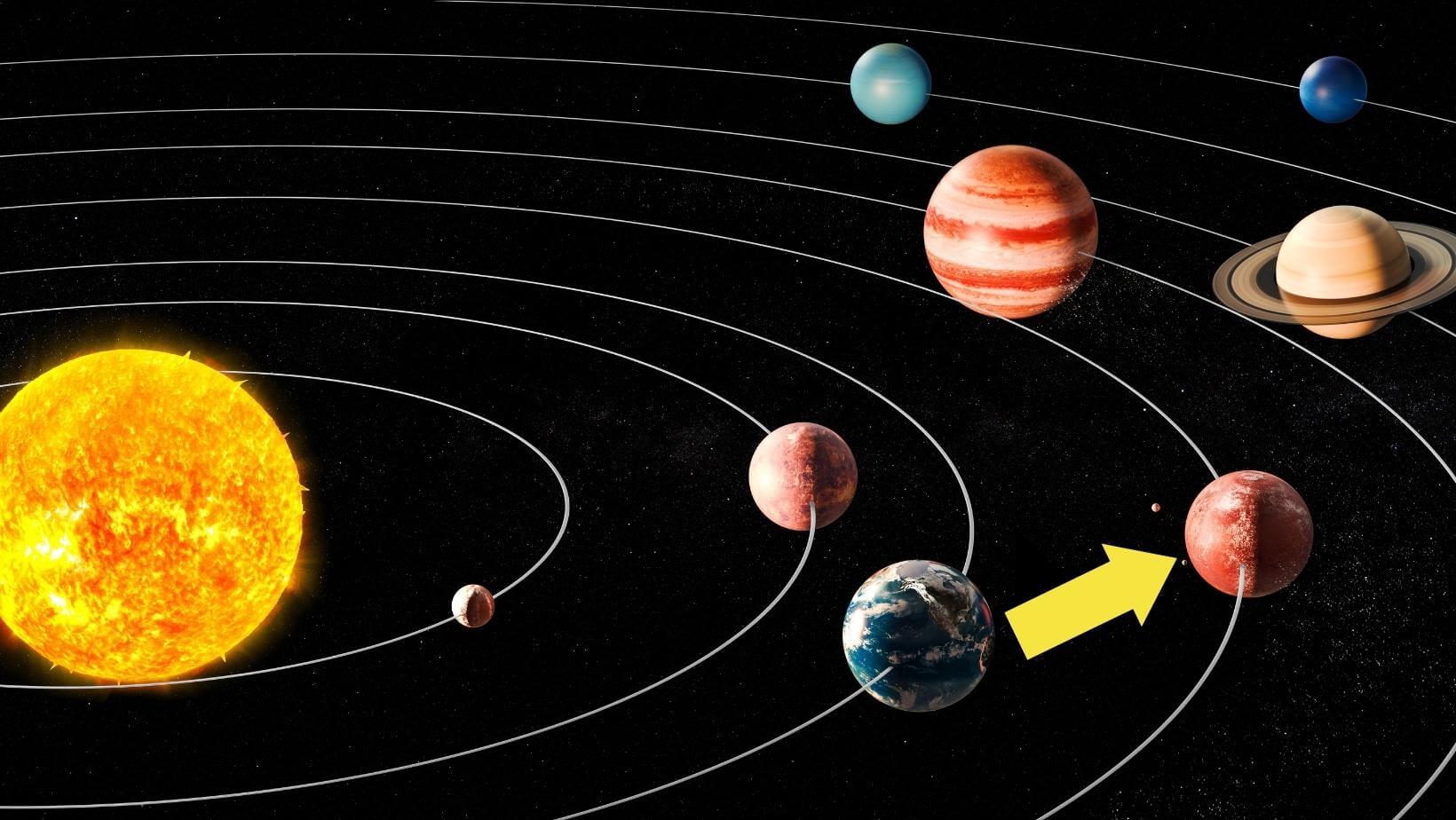The distance between Earth and Mars in our Solar system is not constant, because of the difference in their positions inside their orbits. It changes as both planets move in their orbit around the Sun.
Mars is, on average, about 140-249 million miles away from the Earth. Mars is farthest when they are on opposite sides of the Sun, which is called the “Mars Conjunction”. On the other hand, it is closest to Earth when they are in a straight line with the Sun in the middle, which is called “Mars Opposition”.
When Mars is closer it looks bright and is visible to the naked eye, it comes close enough to the Earth that its surface features can be seen with a simple telescope. When it is farthest it looks very dim and is hard to see in the night sky.

How long does it take to get to Mars?
The trip to Mars is about 7 months and about 300 million miles. It varies depending on several factors, including the speed of the spacecraft, the positions of Earth and Mars in their orbits, and specific mission design. There were various missions to Mars with different time durations:
- Curiosity Rover took the longest time to reach Mars. It was launched on November 26, 2011, it arrived on Mars on August 6, 2012. The Curiosity Rover took approximately 253 days and about 8.3 months to travel from Mars to Earth.
- Perseverance Rover was another mission that was launched on July 30, 2020, it arrived on Mars on February 18, 2021. It took about 203 days or about 6.7 months.
- ExoMars Trace Gas Orbiter (TGO) and Schiaparelli Lander were launched on March 14, 2016. It arrived on Mars on October 19, 2016. ExoMars took about 7 months and around 218 days.
- Mars Reconnaissance Orbiter took the shortest time to reach Mars after its launch. It was launched on August 12, 2005, and arrived at Mars on March 10, 2006. Mars Reconnaissance Orbiter took 6 months and 29 days to travel from Earth to Mars.
Also read: How we can generate oxygen on mars?
Can humans travel to Mars?
Yes, humans can travel to Mars, but it is a challenging endeavor. It involves developing advanced spacecraft, ensuring astronaut safety on the long journey, landing safely on Mars, and providing everything astronauts need to survive.

How far is Mars from Earth in a light year?
The distance between Mars and Earth is about 4. 2×10−5 light years. A light-year is the distance that light travels in one year, which is approximately to about 5.88 trillion miles. The distance between Earth and Mars is a tiny fraction of a light-year, making it a relatively short distance in astronomical terms.
How far is Mars from Earth in light-time?
It takes about 12 minutes and 42 seconds for the light to travel from Mars to Earth. That means when scientists observe Mars through telescopes or communicate with spacecraft on Mars, they are receiving or seeing data that is slightly delayed by this 12-minute light-time.
When is Mars closest to the Earth?
Mars is closest to Earth around 34.8 million miles during a celestial event called “Mars opposition”. This happens about every two years when Earth and Mars line up with the Sun in between. Mars is at its nearest point to Earth during a Mars opposition, making it appear brighter and bigger in the night sky.

When is Mars far from Earth?
Mars is farthest from Earth approximately about 249 million miles when it is on the opposite side of the Sun from Earth. This alignment is known as the “Mars conjunction” and the distance between them is the greatest. This happens about every two years when Mars, Earth, and the Sun are in a straight line, but Mars is on the opposite side of the Sun from Earth.
Why does the distance between Earth and Mars vary?
The distance between Earth and Mars changes because both planets move in slightly oval-shaped paths, around the Sun. Sometimes they come closer together, and other times they move farther apart. This happens because of their changing speed as they go around the Sun and because their orbits aren’t perfectly aligned. So, the distance between them changes as they move in their paths.
Is Mars the closest planet to Earth?
Mars is not the only planet that is close to Earth. The closest planet to Earth is Venus. Venus and Earth both are inner planets, also known as terrestrial planets, and they are often referred to as sister planets because of their similar size and composition. Venus is about 38 million kilometres away from Earth.

Who was the first to calculate the distance from Earth to Mars?
The Italian-French astronomer Giovanni Cassini first calculated the distance between the Earth and Mars in early 1672. Cassini carefully observed the positions of Mars and background stars during a Mars opposition. He envisioned the common distance between Earth and the sun, which is called the astronomical unit. This calculation was a widespread step in information about the spaces within our solar system and the distance between Earth and Mars.
How do scientists measure this distance?
Scientists measure the distance between the Earth and Mars by using radar, like a massive echo. They send radio signals from large antennas on Earth and Mars. When the signals bounce back, they time how long it takes. By knowing the time and the speed of light, they can figure out the distance. They also use the positions of distant stars and two radar stations on Earth to make a triangle. By measuring the angles of this triangle, they can calculate the distance to Mars. Moreover, they look at how radio signals exchange in frequency when Mars is moving closer or farther away. This helps them determine the distance too.

